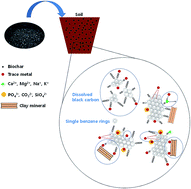Effects of aging and weathering on immobilization of trace metals/metalloids in soils amended with biochar
Abstract
Biochar is an effective amendment for trace metal/metalloid (TMs) immobilization in soils. The capacity of biochar to immobilize TMs in soil can be positively or negatively altered due to the changes in the surface and structural chemistry of biochar after soil application. Biochar surfaces are oxidized in soils and induce structural changes through physical and biochemical weathering processes. These changes in the biochar surface and structural chemistry generally increase its ability to immobilize TMs, although the generation of dissolved black carbon during weathering may increase TM mobility. Moreover, biochar modification can improve its capacity to immobilize TMs in soils. Over the short-term, engineered/modified biochar exhibited increased TM immobilization capacity compared with unmodified biochar. In the long-term, no large distinctions in such capacities were seen between modified and unmodified biochars due to weathering. In addition, artificial weathering at laboratories also revealed increased TM immobilization in soils. Continued collection of mechanistic evidence will help evaluate the effect of natural and artificial weathering, and biochar modification on the long-term TM immobilization capacity of biochar with respect to feedstock and synthesis conditions in contaminated soils.



 Please wait while we load your content...
Please wait while we load your content...